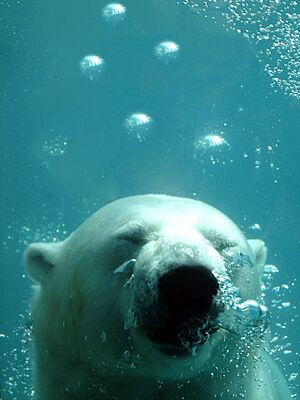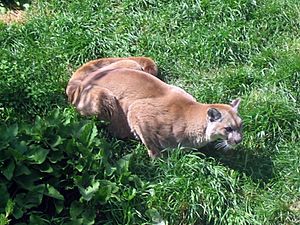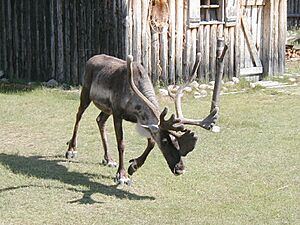Zoo Sauvage de St-Félicien facts for kids
| Date opened | July 17, 1960 |
|---|---|
| Location | Saint-Félicien, Quebec |
| Coordinates | 48°40′56″N 72°30′40″W / 48.6822909°N 72.5112247°W |
| No. of animals | 1,000 |
| No. of species | 80 |
| Annual visitors | 166,105 (2008) |
| Memberships | CAZA |
The Zoo Sauvage de St-Félicien (which means Wild Zoo of St-Félicien in English) is one of the biggest zoos in Quebec, Canada. It's located in Saint-Félicien. This special zoo focuses on protecting animals that live in cold, northern (boreal) climates. It is managed by a group called The Centre for Conservation of Boreal Biodiversity inc.
The Zoo Sauvage de St-Félicien is a proud member of the Canadian Association of Zoos and Aquariums (CAZA). This means it meets high standards for animal care and conservation.
Contents
History of the Zoo
Starting the Zoo
The zoo first opened its doors on July 17, 1960. It was started by Ghislain Gagnon and six other people. They used an old fox farm that was lent to them. Back then, it was a traditional zoo with animals from both North America and other parts of the world.
In 1961, a non-profit group called the St-Félicien Zoological Society Foundation was created. This group bought land for the zoo, which helped it grow. By 1968, the zoo had over 450 animals from 91 different species. It also had a restaurant and a souvenir shop.
Nature Park Trails
Ghislain Gagnon, the founder, started to think about better ways to keep animals than in cages. This led to a big change! On September 10, 1972, the zoo opened its "Nature Park Trails." This new part of the zoo was huge, covering about 74 acres.
Visitors would ride in a special "train" with screens, like being in a cage themselves. The animals, especially those native to Quebec, could roam freely in large areas. This was a very new idea for zoos! The Nature Park Trails grew even bigger in 1978. It added a new lake and even reproductions of old historic sites like a lumberjack camp.
Big Changes and a New Name
In the early 1980s, the zoo was very popular, with over 300,000 visitors each year. People wanted the zoo to focus more on education. So, the St-Félicien Zoological Society Foundation was formed in 1981 to help make these changes.
Starting in 1985, the zoo began building new habitats that were much better for the animals. Instead of cages, they used walls and ditches to separate visitors from large animals like giraffes and elephants. For carnivores like big cats, they built very large outdoor areas.
In 1986, the zoo faced a challenge, but the community helped save it from closing. After this, the zoo changed its focus. Its new mission was about education, research, and protecting natural and cultural heritage. In 1989, the zoo officially changed its name to the Zoo Sauvage de St-Félicien to show its new direction.
Focusing on Nordic Animals
In the 1990s, the Wild Zoo won many awards for tourism. The zoo's founder, Ghislain Gagnon, retired in 1992. Around this time, the zoo made another big decision. It decided to stop keeping exotic animals that needed very different climates. Instead, it would focus only on animals that live in Nordic (cold, northern) environments.
This change helped the zoo financially because Nordic animals were less expensive to care for in Quebec's climate. It also made the zoo unique.
Many renovations happened in the following years, including new habitats for polar bears. The zoo also added new attractions like the Great Aviary and the Kids Garden. By 1997, the Wild Zoo was open all four seasons, which is rare for Canadian zoos. Animals could now roam freely in many areas, not just the Nature Park Trails. The Wild Zoo became a model for other zoos in Quebec.
Conservation of Boreal Biodiversity
In 2001, the Wild Zoo expanded its mission again. It became the Centre for Conservation of Boreal Biodiversity. This new focus meant the zoo would work to protect the amazing variety of life (biodiversity) in boreal forests. This effort followed the United Nations Convention on Biological Diversity.
As part of this plan, the zoo built the Borealium. This is a special Visitors' Centre that also helps with research, learning, and education. In recent years, the Wild Zoo has even brought back some exotic animal species, but only those that naturally live in boreal environments in places like Asia. In 2010, a new exhibit for animals from Mongolia opened, along with a family area and a small farm.
Polar Bear Cubs
On December 4, 2009, something very exciting happened: a polar bear named Aisaqvak gave birth to two cubs! This was the first time twin polar bears were born at a Canadian zoo. At first, the cubs were only seen on a hidden camera. When they were six months old, in June 2010, they made their first public appearance at the Wild Zoo.
Zoo Exhibits
The Zoo Sauvage de St-Félicien has many amazing areas where you can see different animals:
- Arctic - This is a very popular exhibit. You can watch polar bears swim from an underwater viewing area!
- Mixed Forest - Here, you'll find animals from different forest and ocean environments. Look for harbor seals, river otters, raccoons, porcupines, bald eagles, and wolverines.
- Mountain - This exhibit features North American animals that live in mountain areas. You might see cougars, bobcats, Canadian lynxes, coyotes, grizzly bears, and mule deer.
- Nature Trail Park - This was the first area where animals could roam freely. You ride in a special train to see large mammals like American bison, moose, northern elk, woodland caribou, musk ox, black bear, and white-tailed deer.
- Land of the Caribou - You can observe caribou from Lac Montagnais. You can even paddle canoes on the lake!
- Asia - This exhibit has exotic animals that live in Asian boreal (northern) environments. You can see Amur tigers, red-crowned cranes, and Japanese macaques.
- Mongolia - Opened in 2010, this area features wildlife from Mongolia. Look for Bactrian camels, Siberian ibex, Przewalski's horse, and yaks.
- Mini Farm - This is a fun petting zoo where kids can play with and learn about farm animals. You might see goats, Dexter cows, llamas, chickens, donkeys, and even bull frogs.
Images for kids
See also
 In Spanish: Zoológico salvaje de Saint-Félicien para niños
In Spanish: Zoológico salvaje de Saint-Félicien para niños




